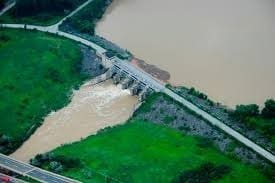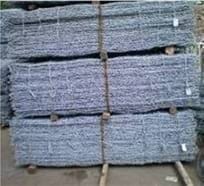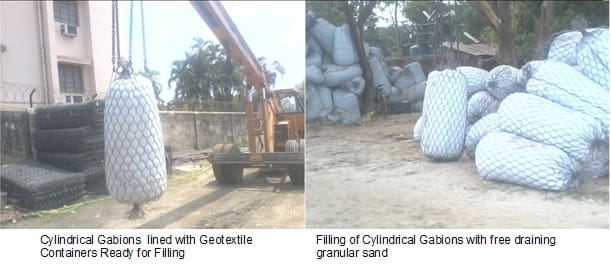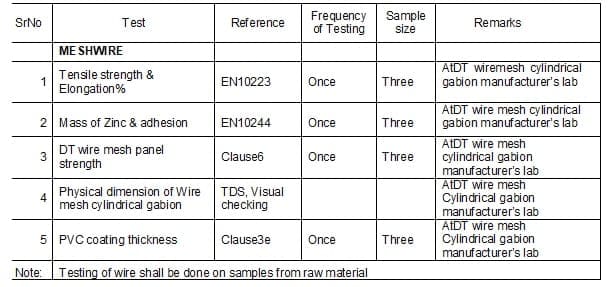V.K.Patil, BTRA and Dr.Ratnakar Mahajan, Maccaferi Environmental Solutions Pvt. Ltd.
Use of composite material using Cylindrical Gabions Lined with Geotextile Material
The cylindrical Gabion lined with Geotextile material is a containment system, which is used for filling dry sand as filler material and placing in position. These are used for preparation of foundation base for the structures, which are not easily accessible, and most of the times under water. The containment system comes handy where availability of stone is less, where sand is available for filling. This system works as a composite system and helps in the areas where velocity of water is relatively high and Geotextile bags alone would not be able to withstand the shear stresses induced by the water on the system components.
The components are made of mechanically woven hexagonal shaped double twisted (DT) galvanized and PVC coated wire mesh cylindrical gabion lined with Non-Woven Geotextile materials used for applications in retaining wall/Scour protection works/river training works/Bank protection works/underwater placement/erosion control works.
The DT wire mesh cylindrical gabion shall be a cylindrical basket made up of mechanically woven hexagonal DT wire mesh and Geotextile as lining material to act as a containment system for sand or any other appropriate fill material. The dimensions of Cylindrical gabions are,
The steel wire shall be heavily zinc coated soft temper steel. APVC coating shall be applied to provide added protection for durability and for use in aggressive environments. In order to reinforce the structure of the system, all mesh panel edges are selvedge with a wire having a greater diameter. Cylindrical gabion shall be supplied with steel reinforcing wires inserted during the manufacturing process to facilitate closing during installation. The top opening of the inner Geotextile lining material shall be stitched at site post filling of the containment system with sand or appropriate material. The hexagonal shape of the mesh provides a better distribution of the working tensions along the wires that form the mesh.
Typical Cylindrical Gabion containment system
Preparation of Cylindrical Gabion containment system:
DT wire mesh cylindrical gabions shall be supplied folded flat and packed in bundles. Larger units may be supplied in rolls and the liner bags for these larger units are supplied separately.
The units are assembled individually in a manner to accommodate the containment system. The mesh forming cylindrical gabion and the Geotextile containment system shall be unfolded from packed bundles. The mesh shall be rolled to form a composite cylindrical shape containment unit.
One end of the DT wire mesh cylindrical gabion shall be tied/closed by pulling the shooting bar. The Geotextile containment shall be supplied with top end open for filling of the sand and the bag shall be stitched with a portable stitching machine post filling the containment unit with the sand or appropriate fill materials.
The bundles of Cylindrical Gabions shall brought to the construction site from the project store and stacked in similar fashion as was done at the project stores.
Cylindrical Gabion bundles at project site.
These bundles shall be stacked on a levelled ground with wooden rafters/sleepers in between them for easy in handling and preventing any damage to the DT mesh and other components like the selvedge wire.
The bundles may be opened at the storage yard for supplying the exact quantity of cylindrical gabions to the construction site. The individual folded cylindrical gabion units shall be handled properly as shown to avoid any damage to the DT mesh and other components.
Post filling installation:
Once the filling is completed, the filled containment system should be neatly stored together and kept in a specified location. The containment system would weigh approximately around 700-850 kgs when filled, depending upon the type of fill material used. Care should be taken that these containment systems are not dragged or pulled along the ground.
For apron construction, the filled containment systems are loaded on a boat/vessel and then dumped into desired location.The lifting of these containment systems is carried out by help of cranes.
For units near the bank portion, can be placed in position with the help of the cranes. Care should be taken that there should not be any damage to the containment units.
Construction Sequence
The sequence of activities that should be followed to carry out the works is as mentioned below,
a. The material once reaching the site shall be stacked and stored properly in dry areas and handled with care in order to minimize the damage to the procured item
b. The location of material storage and the area identified for filling operation should be located in near by area.
c. The area for filling operations must be clean and free from organic matter. The area should have minimum undulations in order to transport the filled containment units to the feeder units easily.
d. The sand available in the sand stock pile should be free from organic matter.
e. The filling operations shall be carried out with due care. The selection of the filling method will be based on actual site condition
f. Once filled the bags will be lifted with the help of Hydracrane sand stacked appropriately in the stacking yard. The stacking yard should be maintained dry and free from burrow animals as a protection measure for the containment unit
g. The filled containment units will then transported to the loading area and then transported to areas where dumping is to be carried out.
h. Small boats to be used to inspect the area post placing or dumping of the containment unit.
Specifications for Gabions
Mechanically Woven Double Twisted Hexagonal shaped Zn+PVC coated wire mesh: All steel wires used in the manufacturing of wire mesh and during construction shall conform to EN10223–3.The wire used for the manufacture of mesh shall have a tensile strength
Between 380-550 N/mm2 and elongation shall not be less than10%.Test shall be carried out
on a sample of at least 25 cm length. All tests on the mesh wire, selvedging wire & lacing wire shall be performed prior to manufacturing the mesh. The DT wire mesh shall have peak tensile strength of 40 kN/m tested as per procedure outlined in clause 6 of this specification.
b) Selvedge wire: The diameter of the selvedging shall be bigger than the wires in the mes The diameter of selvedge wire shall be 3.4 mm and shall have same characteristics as the mesh wire.
c) Lacing wire: The diameter of the lacing wire shall be 2.2 mm and shall have same characteristics as the mesh wire.
d) Zinc coating:
- Zinc coating: Minimum quantities of Zinc shown at Table 1 shall meet the requirements of EN10244-2(Table1 and Class A).
- Adhesion of zinc coating: The adhesion of the zinc coating to the wire shall be such that, when the wire is wrapped six turns around a mandrel having four times the diameter of the wire, it does not flake or crack when rubbing it with the bare fingers in accordance with EN10244.
e) PVC ( Poly Vinyl Chloride ) coating:
- PVC coating thickness: Nominal–0.5mm,Minimum–0.38mm
- Specific weight: 1.3kg/dm3–1.35kg/dm3 in accordancewithISO1183
- Hardness: between 50and 60 Shore D, according to ISO868
- Tensile strength: Higher than 21MPa, according to ISO527
- Elongation at break: not less than 200% in accordance with ISO 527
- UV Stabilized
Wire diameter, tolerances, zinc+ PVC coating shall conform to values indicated in following Table
Table-9.7.1 Characteristics of Mesh wire, Selvedge wire and Lacing wire
Mesh opening: Nominal Dimension D= 100,asperFig.9.7.1
Tolerances in Mesh Opening size:± 5%
DT mesh shall have minimum 10 numbers of mesh openings per meter of mesh perpendicular to twist of mesh.
Procedure for verification of mesh opening
- Cylindrical gabions shall be unfolded on the plain ground.
- Any shrink in the unfolded Gabion Mesh shall be removed, by stretching the Mesh panel.
- c. Marking on the ground shall be made from the Centre of the twist of one mesh and the secon Marking shall be done at 1m distance.
- The number of mesh Openings in the1m shall be counted & verified.
The mesh opening tolerances are indicated in Table-9.7.1 as per EN10223–3
Dimensions of DT wire mesh cylindrical gabion
DT wire mesh cylindrical gabion shall be manufactured in a standard length of 2m with tolerance of ±5%.Table-9.7.3 indicates standard sizes of DT wire cylindrical gabion Other roll sizes may be required as per site conditions subject to the Engineer’s approval. For non standard roll lengths there may be some variation outside the tolerance limit from the nominal size shown in the contract drawings.
Table-9.7.3 Standard sizes of DT wire mesh cylindrical gabion
Testing and Acceptance criteria:
Testing shall be done on raw material as per codes specified in Table 9.7.4. Approval for the material shall be obtained in the writing from the Engineer before actual start of supply. The manufacturer of the DT wire mesh cylindrical gabion shall provide manufacturers test certificate for the material with every lot/shipment. Tensile strength test and zinc coating test on basic wire shall be done on one sample per every 10,000 numbers of units supplied. The manufacturers test certificate for DT wire mesh cylindrical gabion shall be provided for certifying that system conforms to all the technical and special requirements.
Table 9.7.4
Specifications for Geotextile material
Please refer clause no. 7.10 & 7.11 of the same report for the above material specifications.
Cost of construction of Cylindrical Gabion Lined with Geotextile Material –toe Protection/km length
Canal after Lining
CASE STUDY 5: Project: Bank Protection Works in River Ganga Adjacent to Residential Complex at Budge Budge, Kolkata Name of the Client: Cheviot Company Ltd., Year: 2014
Project Details: Various phenomenons are observed in the sea sand oceans where the river mouth opening is funnelled into shallow and narrow river sections. Tidal Bore is one such phenomenon which occurs in the estuary zone. There are very few locations around the globe where this phenomenon occurs, Budge Budge region of Kolkatais one such location in India where the phenomenon occurs. The intense turbulence and the hydraulic jump, caused as result of the Tidal Bore, has lead to damage of the compound wall of Caledium Jute Mill.
Floods that occurred during the year 2013,damaged the compound wall of the Caledium Jute Mill. The anti-erosion works carried out during 2014 got submerged underwater during the occurrence of the tidal bore. The erosion measures constructed with Geotextile Bags, Cylindrical Gabion Containment System, Double Twisted Steel Wire Mesh Netting, Gabion were used to prevent survived the tidal bore and protected the banks. After the occurrence of the last tidal bore consider- able amount of silt deposit was noted.
Placed Geotextile Bags on Slope Handling of Cylindrical Gabion Containment System
CASE STUDY 6: Project: Erosion Protection Works along Banks of Brahmaputra River, Rohmoria, Assam, India Name of the Client: Water Resources Department, Assam Year: 2014
Project Details: Over the past 20 years, the river Brahmaputra has destroyed many paddy fields, homes, schools and plantations in the village of Rohmoria. Brahmaputra channel belt is highly dynamic due to the in cessant structural changes in the basin part and the basin margin areas as well as the sediment load dumping patterns. Rohmoria, in the upper reaches of the Brahmaputra River in Assam, is an area most severely affected by river erosion. This area is located about 20 to 30 km away from Dibrugarh town in the up stream direction of t he south bank of Brahmaputra River. The area has witnessed erosion for the last sixty years and more than 25 villages have been wiped out by erosion
In June 2012, the flood situation in Assam deteriorated more than1,000 villages and water level in other villages was about five feet high. The anti-erosion work constructed in April 2012 was totally submerged under water and In some part flood water passed over the protection work.
The erosion protection measures constructed with Geotextile Bag survived the flood and protected the banks .After flood, considerable amount of silt deposits was noted which is an indication of success of anti-erosion works along the river banks.
Sourcing of the Bank of River Brahmaputra /Condition of Geotextile Bags & River Bank after Flood













